
375
The fiberglass revolution in boats really hit its stride in the 1970s. Builders experimented, learned, and improved construction processes during the 1960s, so by the early 1970s, there were a lot of big- time builders pumping out a lot of good boats. In the East was Pearson Yachts; in the Midwest was Tartan Marine; in the South, Hunter Marine and Irwin; in Canada, C&C Yachts flourished; and out West were Jensen Marine (Cal), Ericson, and Columbia Yachts, to name just a few of them.
Narrowing The Field
In selecting a handful of 30-footers for review, we figured why review a boat no one can find? So we browsed online listings for plentiful boats. We also consulted our own files for old brochures, lines drawings, and owner comments, as well as past reviews of each model.
While there were at least several dozen 30-footers built in the U.S. during the hippy-dippy days of Woodstock, The Smothers Brothers, and Watergate, the most enduring are those built by the major builders—all-around family boats sometimes called racer/cruisers or cruiser/racers. Whatever you call them, they are fun to sail and have sufficient accommodations for a family to live aboard for a week’s vacation.
The facing table shows the nine models we settled on for preliminary discussion: Tartan 30, Pearson 30, Catalina 30, Hunter 30, Irwin Competition 30, Newport 30, Cal 2-30, O’Day 30, and C&C 30. For various reasons, a number of interesting 30-foot designs are omitted—the S2 (1977), Sabre 30 (1979), and Dufour Arpege (1968) come to mind—primarily because they are on the cusp of a different time period where they seem a better fit.
Before we move onto the chosen three, here are brief notes on six models dropped in the final cut.
C&C 30
More than 800 C&C 30s were built between 1973 and 1984, making it one of North America’s most successful 30-footers of all time. Though C&C was a pioneer in the use of balsa core in sandwich hull construction, the early C&C 30s have solid-glass hulls. Like other C&Cs of this period, the keel and rudder are swept aft.
Cal 2-30
C. William Lapworth was the designer for nearly all of Jensen Marine’s (Costa Mesa, Calif.) many models. The 2-30 was in production from 1967-1973, followed by the 3-30, which lasted until 1976. Cals have stout solid fiberglass hulls, but fairly plain interiors.
Hunter 30
The Hunter 30 was an early model from Hunter Marine, a spin-off of the Luhrs’ family’s powerboat company, Silverton. The boat was in production from 1974-1983, with more than 1,000 built. It came with a deep keel or keel/centerboard. The rudder was skeg-hung. The designer was John Cherubini, who worked for Hunter at the time. Marketed for value, workmanship was below average.
Irwin Competition 30
Based in Florida, Irwin Yachts built three different 30-footers in the 1970s: the Competition 30 (1972), Citation 30 (1978), and the plain ol’ 30 (1975). All designed by Ted Irwin, one-time kingpin of southeastern sailboats who fell from grace with a thud. Shoddy workmanship resulted in lawsuits he couldn’t overcome. Many of his designs, however, were quite good. The Competition 30 was configured to rate as a 3/4-tonner under the International Offshore Rule (IOR).
Newport 30 (PHASE ii)
Capital Yachts (Harbor City, Calif.) introduced the Gary-Mull-designed Newport 30 PHII in 1971. Like Hunter and Irwin, Capital Yachts’ boats were built to a price. Like the Irwin Competition 30, the Newport was designed to compete as a 3/4-tonner under the IOR. It’s noticeably lighter than many of these boats, and has a shorter waterline.
O’Day 30
More than 350 O’Day 30s were built between 1977 and 1984. Designed by C. Raymond Hunt Associates and built by Bangor Punta Marine, the boat came with a full keel or keel/centerboard (3’6″-7’2″). In 1984, the stern was stretched to make the O’Day 31. By some reports, the Ranger 30 and O’Day 30 share the same hull. (Bangor Punta bought the Ranger and Cal lines from Jensen Marine.)
Bottom Line
At this age, maintenance history is key. Any upgraded and well-preserved specimen from the above group may serve well as a family coastal cruiser, but we’d focus on the three finalists on the following pages: the Pearson 30, the Tartan 30, and the Catalina 30. All are fin keel, masthead sloops, but each has unique features that sets it apart and will appeal to certain buyers.
The Pearson 30 is the smallest of the three, but a good sailing boat that still competes in club races. It’s the lowest priced of the three. If you’re counting dollars, grab the best one you can find at your price.
The Tartan 30 has a stronger following than the Pearson, partly because of its S&S pedigree. It, too, sails very well. Engine placement poses some complications, but you can get used to it.
The Catalina 30 is the logical choice for the family battlewagon. It’s heavier, roomier, newer … and more expensive. With a displacement/length ratio of 291 and a sail area/displacement ratio of 15.1, however, don’t expect performance matching the Tartan 30 and Pearson 30.
Budget-friendly Pearson 30 reflects Bill Shaw’s growing influence.
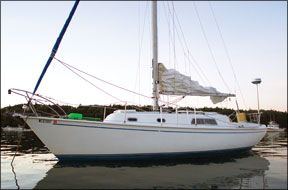
288
The Pearson 30 was introduced in late 1971, and when the last boat went out the door in 1980, 1,185 units had been built. Most were sold in the early and mid 1970s. All were built in Portsmouth, R.I. The P30 was succeeded by the Pearson 303.
Design
Bill Shaw joined Pearson Yachts in 1965, after Grumman bought the company from Everett and Clint Pearson, and during the following few years, he began to exert his influence on the design of the yachts. Fin keels and spade rudders replaced full keels with attached rudders, underbodies became shallower, and displacement less. In short, Shaw modernized the Pearson fleet, and the Pearson 30 is a good example of contemporary design at that time, in particular the swept-back keel and scimitar-shaped rudder. George Cuthbertson was drawing similar appendages at C&C, noting that test-tank data indicated super speed, but on the water, they proved not as efficient upwind as vertical keels and rudders with higher aspect ratios. Extra care must be taken in blocking the boat if not in a cradle.
Our July 15, 1984 review of the Pearson 30 added these comments: “The boat’s underwater shape is somewhat unusual. The hull is basically dinghy-shaped. The sections aft of the keel are deeply veed, however, so that deadrise in the forward and after sections of the boat is similar. Coupled with a fairly narrow beam by today’s standards, this provides a hull form that is easily balanced when the boat is heeled—an important consideration in this relatively tender 30-footer.”
Construction
The hull is a solid laminate with alternating plies of 1½-ounce mat and 18-ounce woven roving. The skin coat under the gelcoat is two layers of mat to prevent the pattern of woven roving from showing (print-through). The external flange of the hull-deck joint is secured with self-tapping screws and then fiberglassed. The deck is balsa-cored for stiffness.
Interestingly, the Pearson 30’s lead ballast is encapsulated in the fiberglass keel molding, which means there are no keel bolts to worry about. This is somewhat unusual for a fin-keel boat.
About the only problem particular to this boat is the rudderstock. Early boats had aluminum rudderstocks, some of which broke, prompting the company to replace the approximately 200 others with stainless steel. Even the stainless steel stocks were not without problems, turning as they do in Delrin bushings, which wear and cause slop in the steering system. They are owner replaceable, however, by removing the tiller fitting and dropping the rudder.
Molded fiberglass floor pans and headliners are bonded to the hull and deck. Through-hull valves may be gate valves (like garden faucets) or positive action seacocks; chainplates are properly through-bolted to structural bulkheads.
Pearson Yachts’ construction methods were above average.
Performance
Though not designed specifically as a racer, the Pearson 30 enjoyed many successes in IOR and Midget Offshore Racing Club (MORC) classes. In fact, it won the ¾-Ton North American championship in 1972. And it was a very popular club racer. It balances well and is quick through tacks. On the downside, it is tender. Our 1980 reviewer wrote, “In 15 knots apparent wind, we find that the boat is almost overpowered with the full main and 150 percent genoa. Gusts of 12-14 knots bury the rail, slowing the boat. The P30 does not, however, carry any substantial weather helm even when overpowered. Any tendency to round up or spin out can usually be controlled by a strong hand on the tiller and easing the mainsail.”
For family daysailing and cruising, smaller headsails are recommended.
Still actively raced in local fleets, a typical the Pearson 30 has a PHRF number of 174 seconds per mile.
Accommodations
The interior layout of the Pearson 30 is straightforward, with a V-berth forward, small enclosed head, settees in the main cabin, a quarter berth aft to port, and a compact galley in the starboard quarter area. The port settee converts to a double berth, so the plan totals six berths, which are more people than you’d want to spend much time with on a 30-footer.
The four portlights in the head and forward cabin are opening, which combined with the forward hatch provide decent ventilation. Unfortunately, the forward hatch isn’t big enough for emergency exit. There is no anchor well in the foredeck, a feature that became more common later in the ’70s.
There’s adequate stowage under, behind, and above the settees. The 1984 reviewer wrote: “Although the lockers are sealed to the bilge at the bottom, owners report that, with their boat heeled, bilge water finds its way into the lockers by running up the inside of the hull behind locker partitions, then down into storage spaces. Most dinghy-hulled boats lack real bilge space or a sump, and as little as a gallon of water in a boat of this type can be annoying.”
Other shortcomings are limited engine access (though not any worse than most boats of this size), and a galley sink and spigot that partially block the companionway. On the upside, the interior is light and airy. Headroom is 5’ 11″ in the main cabin.
Concerns
As with any boat of this age, one should ask the surveyor to look closely for delamination of the core and deck skins, separation of the hull-deck joint, water in the rudder, corroded electrical wiring, corroded through-hulls, and hoses that need replacement.
On early Pearsons the cockpit scuppers were connected to the bottom of the hull by fiberglass tubes, rather than hoses and seacocks/through-hulls. Though probably safe and secure, this drain system does not satisfy American Boat & Yacht Council standards.
As noted earlier, there are just a few areas in which the Pearson 30 falls short of quality building standards, principally the rudder stock design in which bushings wear faster than usual.
Pearson Yachts once ran one of the best customer service departments in the business; alas, it’s been out of business for more than 20 years, and several of the more helpful owner association web sites seem to have disappeared.
Conclusion
The Pearson 30 is a fun boat to sail—quick and responsive. It has the lowest displacement/length ratio (238) and highest sail area/displacement ratio (17.3) of the three. If you like performance, the fact that it’s a little tender shouldn’t bother you much. Reef or just enjoy the ride. It’s not a big 30-footer, but nicely proportioned and of better- than-average construction. There are quite a few on the used boat market in the low and mid-teens, enabling bargain hunters to get into a full-size boat for not much money. Asking prices we saw online, for all years, average around $14,000, with lows around $8,000 and highs around $25,000.
Tartan 30 brings fine S&S cachet within reach of ordinary Joes.
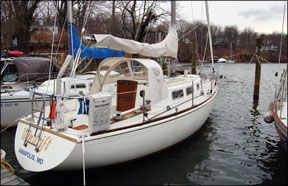
288
Built by Tartan Marine in Grand River, Ohio, and at a plant in Hamlet, N.C., between 1971 and 1980, the Tartan 30 was one of the first designs introduced by Charlie Britton after buying out partner Ray McLeod. The company could complete a boat in less than
4 days. It filled in the gap between the Tartan 27 and Tartan 34. Production totaled 630 units.
Design
The Tartan 30 (like the 27 and 34) was designed by Sparkman & Stephens, probably the world’s most prestigious yacht design firm at that time. The lines are clean and crisp. Like the Pearson 30, its LOA is 29’11,” so it could qualify for competition under the MORC, a rating rule under which it proved quite successful. The bow is raked, and the reverse transom gave it a very modern look for the early 1970s. It has a fin keel and skeg-mounted rudder; a Competition model offered a taller mast (by 3 feet), deeper keel (5’6″ vs. 4’11″ for the standard model), and 500 pounds more ballast. It’s beamier than the Pearson 30, and of about the same displacement, but with a slightly shorter waterline. The rig is fairly high-aspect ratio with large headsails.
A highly unusual feature is the location of the Atomic 4 auxiliary amidships, under the dinette table. This places the considerable weight of an engine exactly where you want it most, near the center of gravity, to minimize hobbyhorsing, which slows a boat and is uncomfortable. Access is better than the usual location aft behind the companionway. And that space is opened up in the T30. The disadvantage is it takes up space in the saloon, particularly seatspace and legroom at the table.
Construction
The lamination schedule is typical of this period: hand-laid mat and woven roving. Liners make for an easy-to-clean interior, but make customizing difficult; they also tend to sweat more than wood interiors, and are noisier.
Ballast is external lead hung on 1-inch stainless steel keel bolts. The rudder is partially supported by a bronze shoe secured to the skeg.
Interior and exterior wood is teak. The sole is covered with cork, a quality home flooring material of the 1950s and ’60s.
Of the rig, our Jan. 15, 1987 review noted: “The rig, like most of those specified by Sparkman & Stephens, was designed to be practically indestructible. Given its inherent strength, look primarily for the effects of corrosion at the spreaders and the butt. Many 30s have been fitted with babystays in lieu of forward lower shrouds. For typical cruising we think the babystay is a pain and probably unnecessary, so we’d make it detachable.” Some owners added babystays as a cure for mast pumping. The standard rig has just single lower shrouds.
Early T30s had bronze pipe (no flanges) for through-hulls as well as gate valves instead of seacocks. Diligent owners will have replaced both by now, but it’s worth checking.
Blistering of all boats was not as common as later in the ’70s and into the ’80s, but there were isolated cases for which one should be on guard.
Tartan’s quality of construction, in the early ’70s, was at least as good as Pearson’s, in some respects better, in others not. It was certainly better built than the Catalina.
Performance
The Tartan 30 is a wholesome design with few bad habits. Our 1987 review said, “The Tartan 30 sails well. In a breeze to windward—perhaps the best test of any boat—she is at her best: comfortable, stable, reasonably handy, and modestly dry. Off the wind, she is more steerable than a host of successors with free-standing spade rudders and dagger-thin keels. Only on a broad reach with biggish following seas can her weather helm be tough to handle. Under such conditions, good sail control hardware—vang, traveler, reefing, adjustable backstay, etc.—is important.”
The skeg helps provide good directional stability or tracking, and the narrow sheeting angles (due to inboard genoa tracks) contribute to narrow tacking angles. The largest T30 PHRF fleet in the U.S., on Lake Erie (20 boats), races with a handicap of 168, though most of the other fleets, including the 18-boat fleet on the Chesapeake Bay, rate higher, around 177. So it and the Pearson 30 are very similar in boat speed, though the Pearson has the edge in light air, where the Tartan’s shorter waterline is a disadvantage.
Accommodations
Two interior plans were offered, one with an aft galley, the other with a midship galley, the latter with two quarterberths, the former with a single quarterberth to port and a settee amidships to starboard, where the galley is in the midship model. With either, there are simply too many berths. The aft galley seems preferable mainly because of the two opposing settees in the saloon.
One reason why five berths in a 30-footer is at least one too many is that berth length is diminished; this is particularly evident in the V-berth. Another reason is that quarterberths subtract from available stowage space; instead of stowing sails in cockpit seat lockers, on this boat they end up in a quarterberth.
The midship galley is, of course, more spacious than the aft galley, but neither has a stove/oven combo. Owners note that when the boat is heeled, the sink can fill and slosh water onto the sole.
The cockpit is of average size and would be more comfortable if the wood coamings weren’t so low.
Concerns
Beyond the usual issues afflicting old boats, like bedding failing on deck hardware, the Tartan 30 has few peculiarities of construction. A number of owners have installed tie rods between the lower portion of the mast in the cabin, and the underside of the deck, to prevent deflection when the rig is heavily tensioned. Check tabbing of the main bulkhead. Also check the starboard chainplate and its attachment to the bulkhead, which reportedly isn’t as stiff as the port side bulkhead; water migration down a chainplate and into a wood bulkhead is a serious problem. Other issues noted online include inadequate insulation of the ice box, and an engine exhaust system prone to back-siphoning.
Tartans enjoy very active owners groups, especially in the Chesapeake Bay area. T30 owners’ websites have much useful information on troubleshooting and upgrading.
Conclusion
The Tartan 30 is probably the classiest boat of the three finalists. Part of the reason is that Sparkman & Stephens is one of the world’s great yacht design firms, and the work they did for Tartan was very good, with handsome, classic lines. And Tartan construction was above average. Online asking prices start at just under $10,000 and run up to around $23,000, with an average of about $17,000.
The family-friendly Catalina 30 comes with the largest fan club.

288
More than 6,500 Catalina 30s have been built since the boat was introduced in 1974, which must be some kind of record. Its design was continually upgraded over the years, but the first model, the Mark I, was in production through the same period as the Pearson 30 and Tartan 30. The Mark II came along in 1986. Owner Frank Butler has built more than 70,000 boats since he founded the company in 1970, so he must be doing something right. In 2001, the Catalina 30 was inducted into the American Sailboat Hall of Fame.
Design
Butler drew most of the early designs himself, though he has no formal training in naval architecture or yacht design. He was a machinist by trade, and smart. His first design was the Coronado 25, which he’d asked Sparkman & Stephens to design, but they told him it would take two years and they’d first have to check his finances. So he designed the boat himself, with a fiberglass pan interior, which he believes was an industry first (Henri Amel was doing something similar in France.)
The Catalina is three years newer than the Pearson 30 and Tartan 30, and was not intended as a racer, which explains its wider beam and heavier displacement. Like most Catalinas, the 30 is a family boat, best suited to coastal cruising.
Here’s what we said about the design in our Nov. 15, 1980 review: “The boat has a swept-back, fairly high-aspect-ratio keel of the type made popular by IOR racing boats in the early 1970s. The high aspect ratio spade rudder is faired into the underbody with a small skeg. The boat is conventionally modern in appearance. She is moderately high-sided, with a fairly straight sheer and short ends. The cabin trunk tapers slightly in profile, and is slightly sheered to complement the sheer of the hull. When coupled with the tapered cabin windows—a Catalina trademark—this yields a reasonably attractive appearance compared to many modern boats.”
Of course, what was modern in 1980 and what is modern today are two different things. For one, waterline lengths have increased in relation to length overall, which means shorter overhangs, which means bows that are more plumb.
Construction
The hull of the Catalina 30 is solid fiberglass; there is no balsa, no foam, which makes for a heavier boat, but also one that isn’t susceptible to potential delamination. The hull-deck joint is a shoebox, in which the wider deck, with downward-facing flanges, fits over the hull. It is then bonded and fastened with self-tapping screws. A wood sheerstrake glassed to the hull adds strength. The joint is then covered with a vinyl rubrail secured in an aluminum extrusion.
Shoal and deep keels were offered, both external lead through-bolted to the hull.
The masthead rig has upper and double-lower shrouds and is deck- stepped. A wood compression post transfers rigging loads to the keel. A tall rig, for light-air regions, was an option. Check wood spreaders for rot. Early boats had fixed portlights, but these can be upgraded to opening.
Stanchions, double lifelines and double stern and bow pulpits were standard. Stanchions are though-bolted, but backed only by washers, not backing plates of fiberglass or aluminum, which do a better job of transferring loads and preventing cracking of the gelcoat, and possibly the deck laminate, in way of the stanchion bases.
Like Tartan, early models had through-hulls made up of bronze pipe. Gate valves were standard and must be replaced with bronze positive-action seacocks.
Performance
The Catalina 30’s generous beam (for its day anyway) gives it good initial or form stability. And coupled with a conservative sail plan, the boat is stiff, much more so than the Pearson 30. The downside of such beamy hull forms is the tendency to develop weather helm when heeled; so it, like many other modern boats, is best when sailed relatively level.
The smallish sailplan also means that performance in light air is not particularly sparkling. Our 1980 review said, “To get good performance in light air the boat will either have to be ordered with the taller rig, or very large headsails must be carried. If headsails larger than a 150% genoa are carried with the normal rig, turning blocks will have to be added aft in order to get a proper lead to the headsail sheet winches.”
The biggest Catalina 30 PHRF fleets, both in California, rate 180 and 192 respectively; the Pearson 30 is 174 and the Tartan 30 177.
A gasoline Atomic 4 engine was standard; a small, underpowered diesel was optional. Look for a boat that’s been repowered with a newer engine like the Yanmar 3GM30F.
Accommodations
Interior “furniture,” such as berths and galley, are formed by an interior fiberglass pan or module dropped into the hull prior to the deck going on. A fiberglass headliner covers the underside of the deck. These make for an easily cleaned interior, and one that looka nicely finished (albeit like a refrigerator). Such liners do, however, restrict access to parts of the hull and deck, make customizing difficult, and are not as good thermal and acoustic insulators as wood. The bulkheads are teak-faced plywood.
Again, owing to its beam, the Catalina 30’s interior is more spacious than the Tartan 30’s or Pearson 30’s. The V-berth is comfortable, followed aft by the head and hanging lockers; a shower was optional. The engine is located very near the center of the boat, under the short leg of the L-shaped portside settee. Access is very good. There’s a U-shaped galley with alcohol stove/oven to port, and a quarterberth and chart table to starboard. But if you thought the Tartan 30 has too many berths, check this: The Catalina 30 supposedly sleeps seven! Two in the V-berth, two in the convertible portside dinette, one on the starboard settee, and two squished into the “double” quarter-berth.
The interior is spacious and wellplanned, but finish quality is only average.
Concerns
The Catalina 30 is a pretty straightforward boat in terms of both design and construction. No big surprises.
Several potential issues mentioned recently on owner forums: corroded wiring harness between engine and control panel, poor rudder design (corrected with new design in December 1978), wear of rudderstock tube, chainplate attachment to bulkheads, gate valves on pipe through-hulls, and hollows in the lead keel.
A positive with any Catalina is that the company is still in business and able to offer customer support.
Conclusion
Catalina Yachts has been one of the country’s most successful builders because it offers a lot of boat for the money. If construction quality is only average, one must ask, “Do I need more?” Generally, what’s lacking is not structural integrity, but details, like more drawers with dovetail joints and hardwood sides. There’s lots of room in the Catalina 30, and there are hundreds on the used boat market, so you can find a deal. Because the Catalina is a somewhat newer boat than the Pearson 30 and Tartan 30, its prices run higher. Though fixer-uppers can be found, most run between $16,000 and $29,000, with an average of about $22,000.
An examination of 30-footers from the 1970s seems like a good place to begin our comparison of used boats, and the reasons are several: First, though boats 30-plus years old admittedly are getting a little long in the tooth, many are still around, and those well kept may represent great buys on the used-boat market—between $10,000 and $20,000. Second, the 30-foot size is where full cruising accommodations begin, with stand-up headroom, enclosed head, berths for four or five, inboard auxiliary engine, and a decent galley with ice box, sink, and stove-oven possible. Sure, you can find these features in some 27- and 28-footers, but the squeeze is telling.







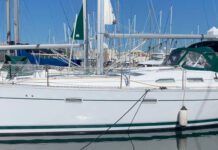







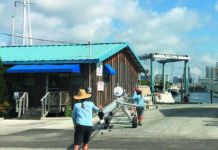




















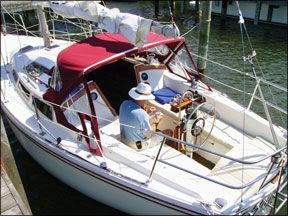




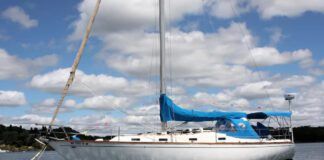
I am looking at a Cooper Seabird 37 mast head sloop, can you point me to any credable reviews on this particular vessel. Any help would be appreciated thank you.